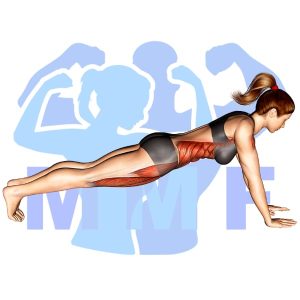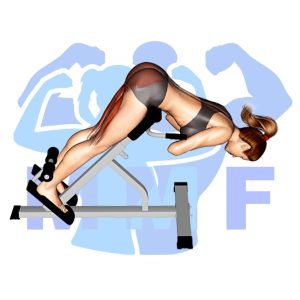Are you tired of feeling like your body is out of sync and unaligned? Do you experience chronic back pain or weak glutes? You’re not alone. In today’s modern world, we spend most of our time sitting down, hunched over our computers or phones, resulting in a weak core and hip muscles that fail to stabilize our hips. But don’t worry, this is a common problem, and there’s a solution: the bridge exercise. In this blog post, we’ll go over the benefits of the bridge, how to do it properly, and modifications to make it more challenging as your strength increases. So, let’s bridge the gap and start feeling strong and aligned again.
Bridge (Plank) Summary
- Primary Muscles: Rectus Abdominis
- Secondary Muscles: Iliopsoas (Psoas Major & Iliacus), Obliques, Pectoralis major, Quadriceps, Sartorius, Serratus Anterior, Tensor Fasciae Latae, and Triceps
- Equipment: Body Weight
- Mechanics Type: Isolated
- Force: Pull
- Utility: Auxiliary

Bridge (Plank) Instructions
- Step up in a pushup position with your arms extended.
- Keep your back straight and spine in alignment.
- This is an isometric hold exercise. Hold for your desired time.
Video Tutorial
Bridge (Plank) Muscles
Target (Agonist)
Synergists
- Iliopsoas (Psoas Major & Iliacus)
- Obliques
- Pectoralis major
- Quadriceps
- Sartorius
- Serratus Anterior
- Tensor Fasciae Latae
- Triceps
Dynamic Stabilizers
- None
Stabilizers
- None
Antagonist Stabilizers
- None

Benefits of Bridge (Plank)
The bridge exercise is an effective strength training exercise that specifically targets the rectus abdominis muscle. This muscle, commonly referred to as the “abs”, is the major muscle responsible for providing core stability and strength. By performing bridges, you are able to effectively engage and strengthen this muscle, leading to increased balance and stability in the core, improved posture and reduced risk of lower back pain. Bridges also help to improve coordination and motor control, as well as increasing flexibility in the hips and glutes. Additionally, performing bridges can help improve body awareness and help individuals become more mindful of their body’s positioning when performing other exercises.
Tips for Performing Bridge (Plank)
If you’re seeking to take the bridge to a new level, then you’ve come to the right place. Using these suggestions will allow you to take full advantage of this amazing workout. Concurrently with toning your abs muscles, increasing movability, and even a reduced possibility of injury can all be accomplished with this exercise. So let’s begin right now and see what these suggestions may accomplish for you.
- 1. Proper form is key – Make sure to keep your back straight and your head up during the bridge exercise to ensure you are getting the maximum benefit from the exercise and to minimize risk of injury.
- 2. Stay focused – Focus on tightening the glutes and keeping your core engaged during the exercise to increase the effectiveness of the bridge.
- 3. Push yourself – Increase the intensity of your bridge exercise by pausing at the top and squeezing the glutes for an extra challenge and even better results.
Benefits and Tips Video
Frequent Mistakes To Avoid
When performing bridge, avoiding typical errors is key to getting the most out of the exercise and avoiding pain. From bad form to not engaging your core, these errors can diminish the productiveness of the exercise and can even raise your risk for injury. Don’t worry, though, it’s not at all difficult as it might seem. You can execute the exercise safely and effectively by understanding the mistakes to avoid and by following the correct steps. So it is time for you to maximize your results from this exercise and enjoy the benefits of a productive workout.
- 1. Doing the bridge without proper form: Not performing the bridge with the correct form can put unnecessary strain on the neck and shoulders, leading to injury.
- 2. Not engaging the core muscles: Failing to engage your core muscles while doing a bridge can reduce the effectiveness of the exercise and make it difficult to maintain good form.
- 3. Holding the bridge too long: Holding the bridge too long can cause fatigue and may lead to poor form, which could cause injury. It’s important to take breaks and keep your form in check while doing this exercise.
Find More Bodyweight Exercises Here
Variations and Complementary Exercises
These exercises are a great way to supplement the exercise Bridge, allowing you to target the same muscles in different ways. Try any of the following variations, complements, or alternatives:
Bench Crunch

Bench Crunch is a popular core exercise that is a great complement or alternative to the Bridge exercise. The Bench Crunch works the same muscle groups as the Bridge, but allows for greater range of motion and intensity. It involves lying on your back on a bench and crunching your upper body up, engaging your core. The added stability of the bench allows you to focus on form and challenge yourself in ways not possible with the Bridge. By alternating between Bench Crunch and Bridge, you can give your core an intense workout that will leave you feeling strong and toned.
V Up

V Up is a great complementary exercise to the Bridge. It works the same muscles while adding an extra challenge. The V Up requires you to lift your upper body and legs off the ground at the same time, while the Bridge focuses more on keeping your glutes and hamstrings engaged. Both exercises are great for strengthening your core and improving your stability and balance. V Up is a great alternative to the Bridge if you’re looking for a challenge, or if you want to switch up your routine.
Straight Arm Crunch

The Straight Arm Crunch is a great alternative or complementary exercise to the Bridge. It works the same abdominal muscles and stabilizing muscles in the lower back as the Bridge does, but in a different way. During a Straight Arm Crunch, you lie on your back with your arms straight out and palms facing up. You then lift your shoulders off the ground and hold for a few seconds before returning to the starting position. This exercise targets the rectus abdominis, as well as the obliques, which work together to stabilize the spine and give you a strong core.
Check Out These Top Bodyweight Exercises
Straight Arm Bridge

The Straight Arm Bridge is an excellent exercise for strengthening the posterior chain muscles, such as the glutes, hamstrings, and lower back. It can be used as a complementary exercise to the Bridge, or as an alternative to it. In the Straight Arm Bridge, the body is kept in a straight line from head to heels, with the arms extended straight out in front of the body. This variation of the Bridge emphasizes more activation of the upper back and core muscles, while also providing greater stability throughout the body. Additionally, it is a great exercise for improving hip mobility and spinal alignment.
Standard Crunch

Standard crunch is a great complementary or alternative exercise to the bridge. This exercise focuses on strengthening the core and improving stability. It is an excellent way to strengthen the abdominals, obliques, and hip flexors while still providing a solid base for the bridge. The standard crunch involves lying on your back with your feet flat on the floor and your hands behind your head. You then lift your torso off the floor, curling your upper body towards your knees. This exercise can be done with or without weights depending on how challenging you want to make it.
Scissor Crunch

Scissor Crunch is an exercise that targets the abdominal muscles. It is a complementary exercise to the Bridge, as it works the same muscles but in a different way. It involves lying on your back and lifting your legs off the floor while moving them in a scissor-like motion. It is a great alternative exercise to the Bridge as it places less strain on the back and helps to strengthen the core. It is also beneficial for improving balance and overall body strength.
Find More Abs Exercises Here
Opposing Complementary Exercises
Combining the Bridge exercise with these other complementary exercises will strengthen your core and help you to create balance and stability. The following exercises focus on working the opposing muscle groups, allowing you to create a stronger, more balanced core.
45 Degree Hyperextension

The 45 Degree Hyperextension is an exercise that helps to strengthen the lower back and glutes. This exercise works the opposing muscle group to the Bridge exercise. This makes it a great complementary exercise to the Bridge, as it works the opposite muscles which helps to create balance in the body. The 45 Degree Hyperextension also helps to improve overall core strength and stability, which is beneficial for many activities. It is important to perform the exercise with proper form, as this will ensure that you get the most out of the exercise and avoid injury.
Straight Leg Cable Pull Through

The Straight Leg Cable Pull Through is a great complementary exercise to the Bridge. It targets the opposing muscle group in the posterior chain, specifically targeting the hamstrings, glutes, and lower back. This exercise is done by standing between two cable machines with a rope attachment and pulling the cable through your legs while keeping your legs straight. This exercise can help to strengthen the hamstrings and glutes, which are important for stabilizing the hips and aiding in the Bridge exercise. The combination of these two exercises can help to improve performance and reduce the risk of injury.
Bird Dog Plank

Bird Dog Plank is a great exercise to complement the Bridge exercise. It works the opposing muscles of the core, including the glutes, rectus abdominus, and obliques. The Bird Dog Plank involves balancing on your hands and toes while simultaneously reaching one arm and the opposite leg outwards. This helps to strengthen the core muscles and balance while engaging the stabilizing muscles in a way that is complementary to the Bridge exercise.
Building Stronger Glutes: The Power of the Bridge
When it comes to building a well-rounded lower body, the bridge is one of the most effective exercises around. This simple but powerful movement targets the glutes, hamstrings, and lower back, helping to tone, strengthen, and tighten those key muscle groups. By performing bridges regularly, you can improve your posture, enhance your athletic performance, and even reduce your risk of back pain. So if you’re looking to sculpt a better booty and boost your overall fitness, the bridge is a must-do exercise to add to your routine.
References: Wikipedia | ExRx.net | PubMed.gov | Comprehensive List of Abs Bodyweight Exercises

